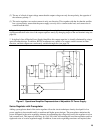
25
half cycle of input ac and hold the voltage drop across the series regulator constant in spite of changes in load
current, output voltage, or input line voltage. Figure 8 shows how varying the conduction angle of the SCR's
affects the amplitude of the output voltage and current delivered by the SCR bridge rectifier of Figure 7. An
earlier firing point results in a greater fraction of halfcycle power from the bridge and a higher dc level across
the input filter capacitance. For later firing times, the dc average is decreased.
Figure 8. SCR Conduction Angle Control of Preregulator Output
The reaction time of an Agilent preregulator control circuit is much faster than earlier SCR or magamp circuits.
Sudden changes in line voltage or load current result in a correction in the timing of the next SCR trigger pulse,
which can be no farther away than one half cycle (approximately 8 milliseconds for a 60Hz input). The large
filter capacitance across the rectifier output allows only a small voltage change to occur during any 8
millisecond interval, avoiding the risk of transient drop-out and loss of regulation due to sudden changes in load
or line. The final burden of providing precise and rapid output voltage regulation rests with the series regulator,
while the preregulator handles the coarser and slower regulation demands.
The preregulator SCRs, together with the leakage inductance of the power transformer, limit high inrush
currents during turn-on. A slow-start circuit allows gradual turn-on of the SCRs while the leakage inductance
acts as a small filter choke in series with the SCRs. Thus, both the supply's input components and other ac
connected instruments are protected from surge currents.
Switching Regulation
The rising cost of electricity and continuous reductions in the size of many electronic devices have stimulated
recent developments in switching regulated power supplies. These supplies are smaller, lighter, and dissipate
less power than equivalent series regulated or series/preregulated supplies.
Although basic switching regulator technology and its advantages have been known for years, a lack of the
necessary switching transistors, rectifier diodes, and filter capacitors caused certain performance problems that
were costly to minimize. As a result, these supplies were used only in airborne, space, or other applications
where cost was a secondary consideration to weight and size. However, the advent of high-voltage, fast


















